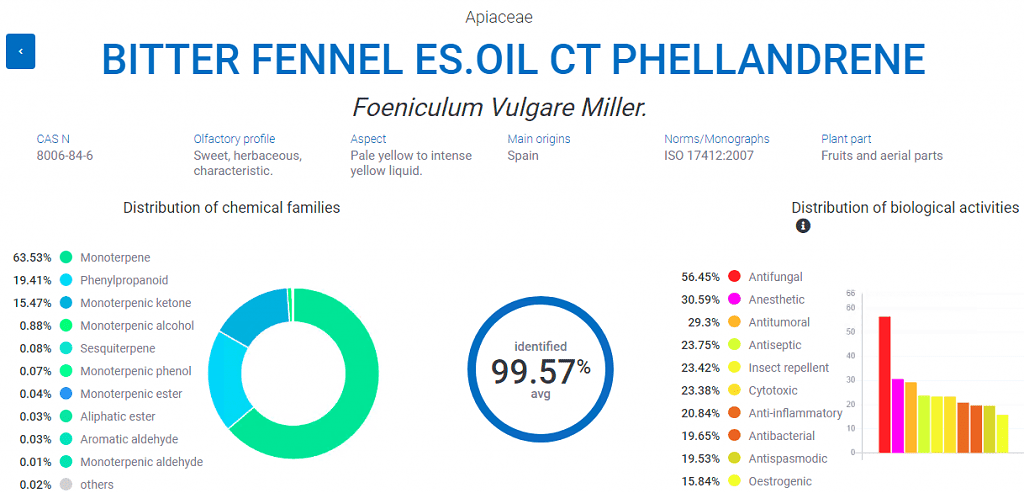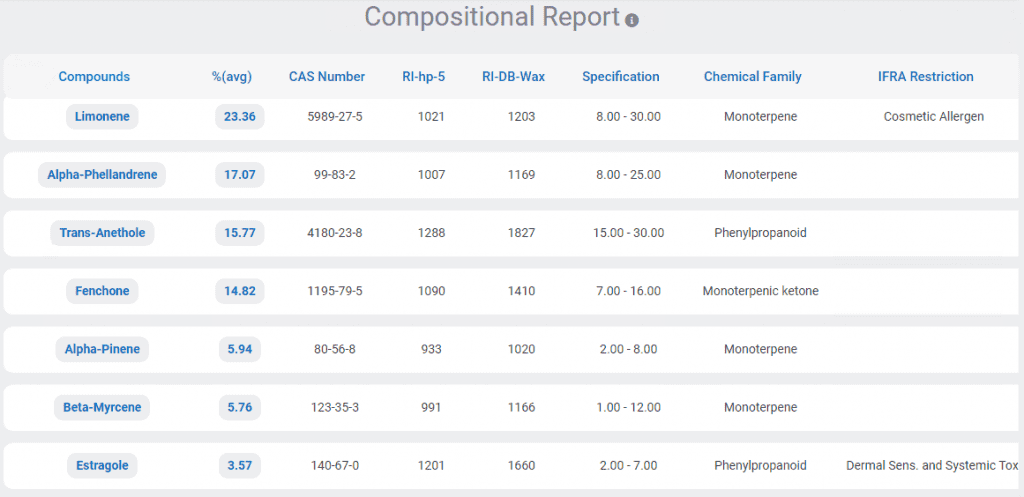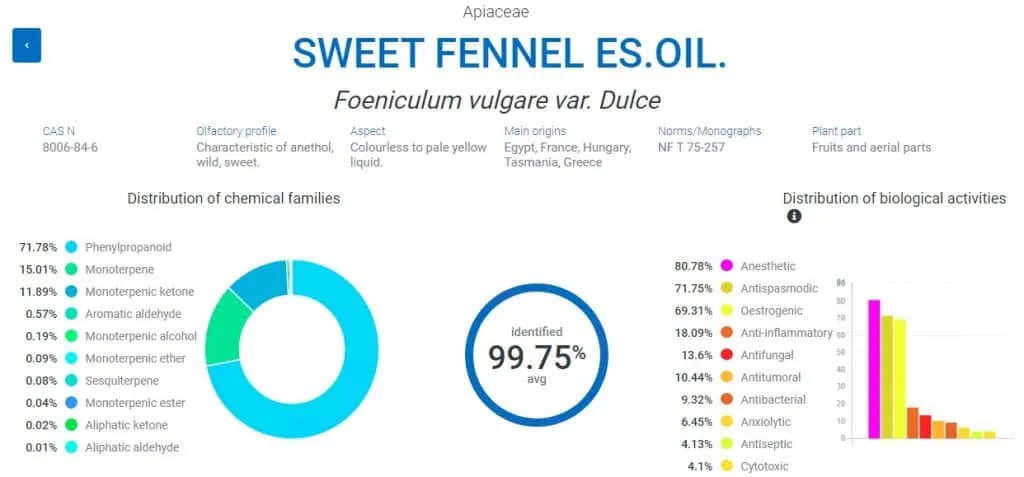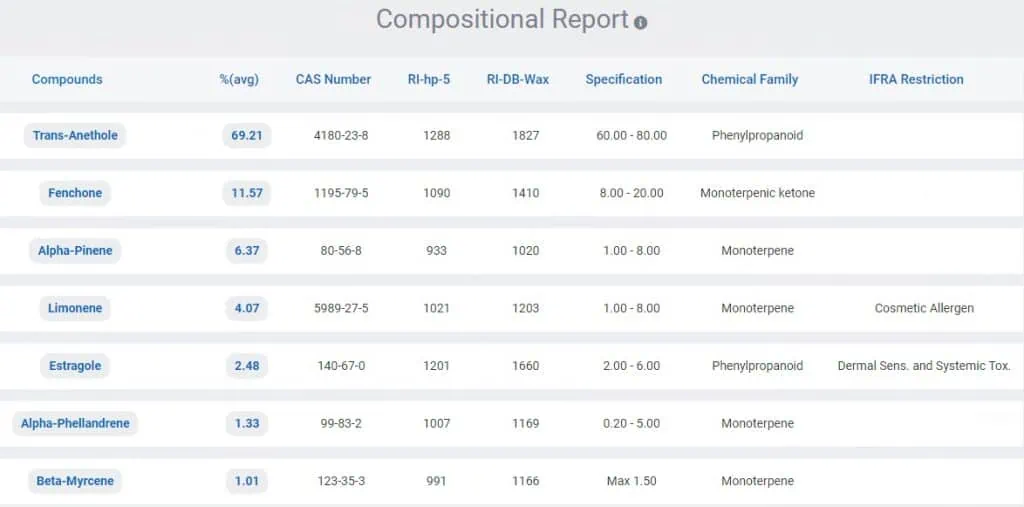| Botanical Name | Foeniculum vulgare Mill. ssp. vulgare |
| Botanical Family | Apiaceae |
| Part of the plant | Fruits and aerial parts |
| Cas Number | 8006-84-6 |
| FEMA Number | 2481 |
| Main Origins | Spain, Hungary, France, Tasmania, Egypt. |
| Harvest Period | August to October |
Although it is a plant of Mediterranean origin (Syria), it is currently cultivated in many countries around the world. It can grow up to 2 m. high and its leaves are deep green. Its flowers have an intense yellow color. It was introduced in the USA around 1600 by Spanish explorers. Charlemagne quotes it in his writings, both for its food use and for phytotherapy.
A quick search in our essential oils web application shows two different types of Fennel predominant in the market:
OIL PRODUCTION
The oil obtained, with a yield of between 1 and 2%, is a slightly yellow liquid with the typical aniseed smell, and powerful herbaceous and spicy notes in the case of the Spanish quality. According to the ISO definition, this oil can also be obtained by rectification from crude oil, increasing its Anethole content.
It is often used in flavoring for food and dental hygiene. It is also used in perfumery, cosmetics, pharmacy and aromatherapy.
CHEMISTRY
Two different chemotypes of fennel oil have been catalogued: “Sweet” and “Bitter”. Their distinction has been explained in several ways. The French AFNOR standard states that the Sweet type is obtained from the seeds of a specific variety called “dulce”. The international standards, ISO and Pharmacopoeia, include these two chemotypes within the same variety “Amara” which is distilled from the seeds or aerial parts:
-The Phellandrene CT, which corresponds to “bitter fenner” is mainly produced in Spain,
-The t-Anethole CT, which corresponds to “sweet fennel”, is mainly produced in Hungary or Tasmania.
The determination of its Fenchone content is crucial in both varieties, not only because it is the component that provides the pungent-potent odor, but also because of the difficulty of being added in commercial or reconstituted qualities, complying with the typical optical rotation of the oil. For this reason, optical rotation is a necessary measure in any oil quality control.
Bitter and Sweet Fennel Oil selection in our essential oils web tool (ChromDB) shows the distribution of chemical families, biological activities and composition report. Average results from authenticated analyses are uploaded every day in each data sheet.
As showed in the following capture of the Bitter Fennel compositional report, the three major constituents are Limonene, Alpha-Phellandrene and Trans-Anethole. Taking a look to the resulting distribution of biological activities, the calculation from the molecular composition shows that the major properties are antifungal and anesthetic. Please note that the synergistic effect between substances has not been taken into account.
In the case of the sweet variety, the three major constituents are Trans-Anethole, Fenchone and Alpha-Pinene. Taking a look to the resulting distribution of biological activities, the calculation from the molecular composition shows that the major properties are antifungal, antispasmodic and oestrogenic. Please note that the synergistic effect between substances has not been taken into account.
SAFETY NOTES
IFRA warns some restricted substances in fennel oils: Estragole (carcinogenic); p-Methoxybenzaldehyde (sensitizer); and allergens in cosmetics: Limonene, Linalool, Neral. Therefore, for safety reasons, its maximum oral dose for adults is 54 mg and its maximum cutaneous (dermal) dose is 1.8%.
Fennel oil can be oxidized, and care should be taken to ensure that it has not been oxidized before using it for therapeutic purposes. The oxidation products of t-anethole can be sensitizing to the skin (cis-anethole, anisaldehyde and anise ketone).
MONOGRAPHS
There are monographs by ISO, FCC, AFNOR and European Pharmacopoeia.
ISO 17412 Oil of bitter Fennel Ssp. vulgare var. amara Phellandrene+ t-Anethol CT
Ph.Eur 1280 Bitter Fennel herb oil Ssp. vulgare var. amara Spanish + Tasmanian CT
Ph.Eur 1279 Bitter Fennel fruit oil Ssp. vulgarevar. amara t-Anethole CT
NF T 75-257 Oil of sweet Fennel Ssp. vulgare var. dulce t-Anethole CT





